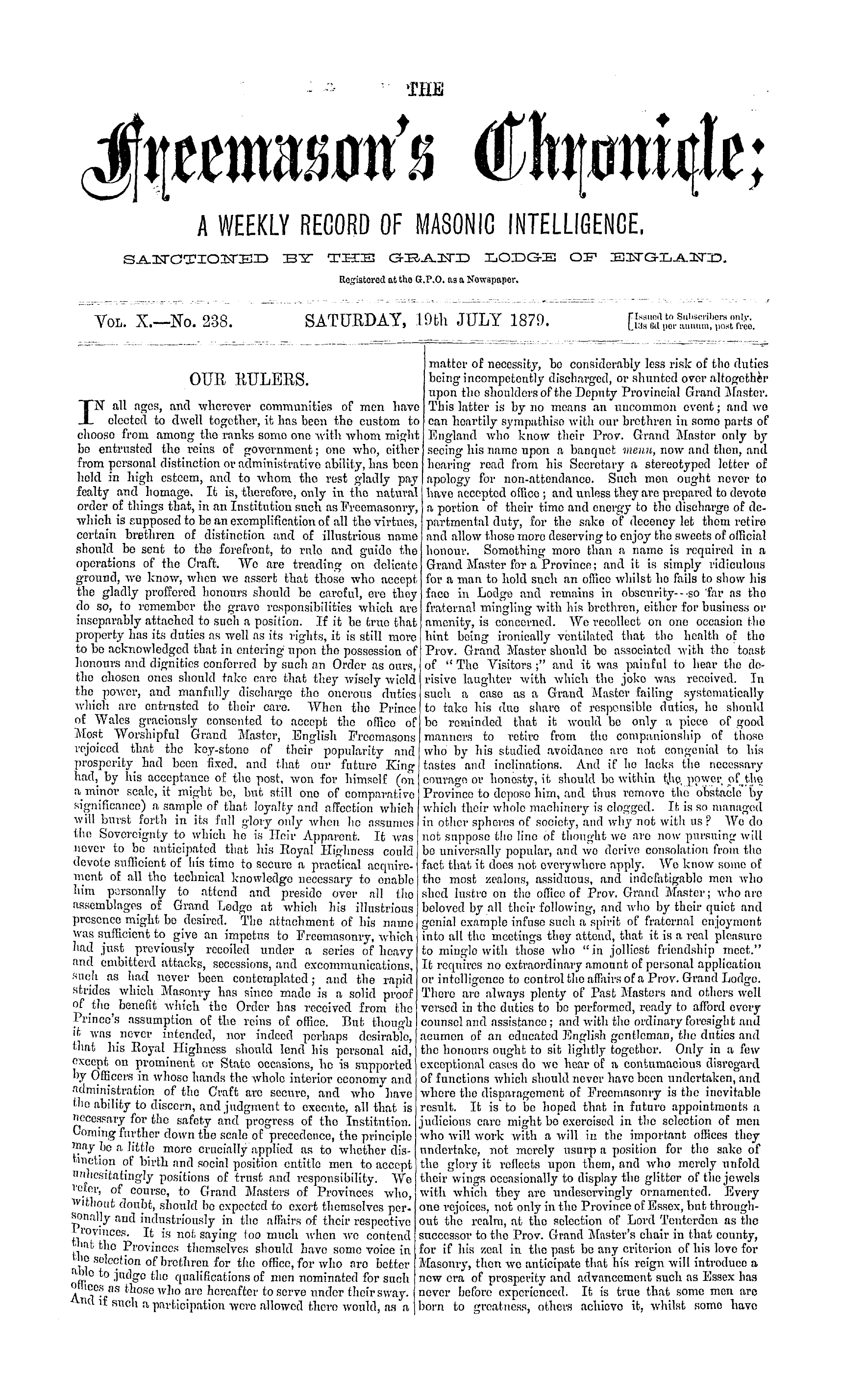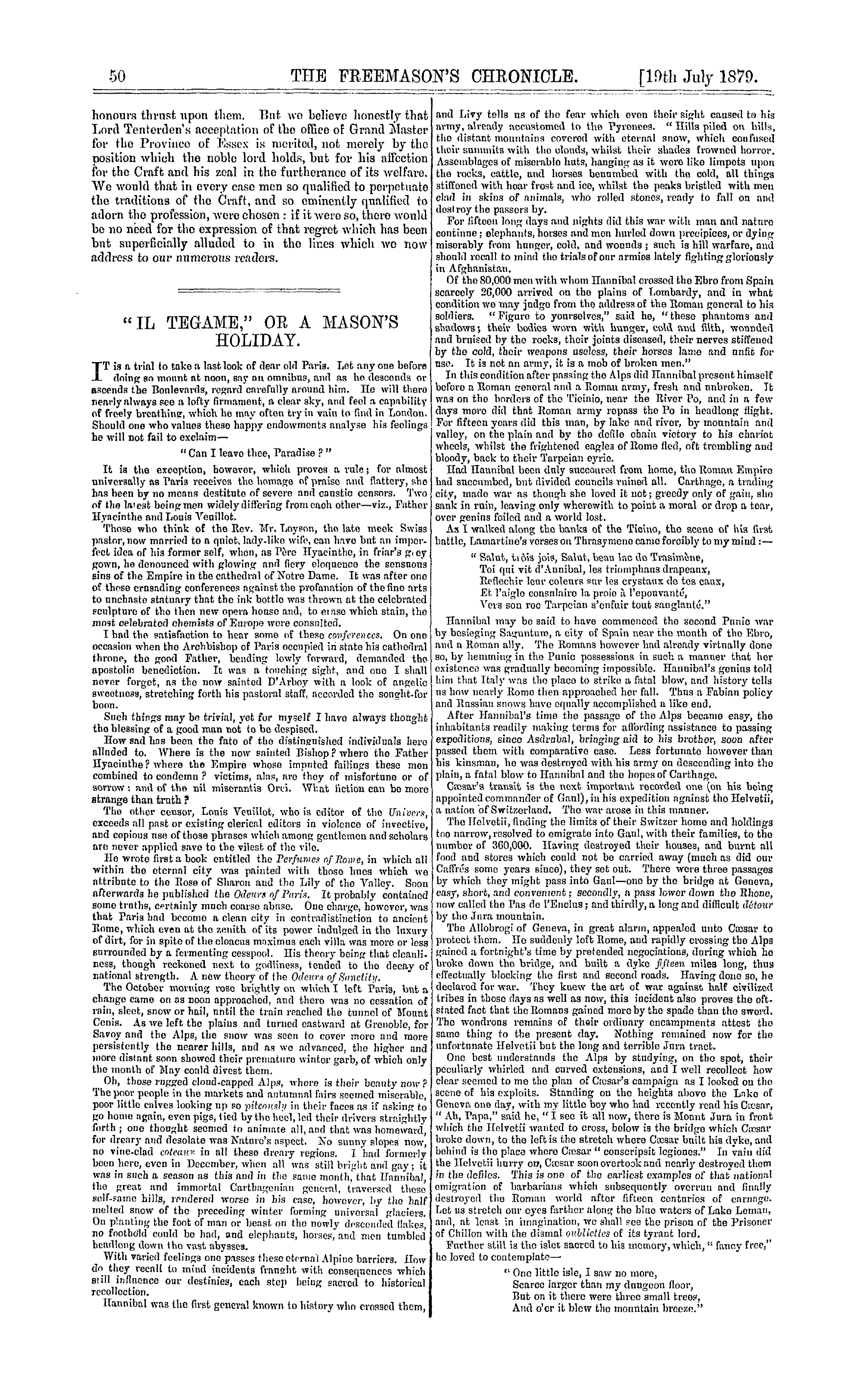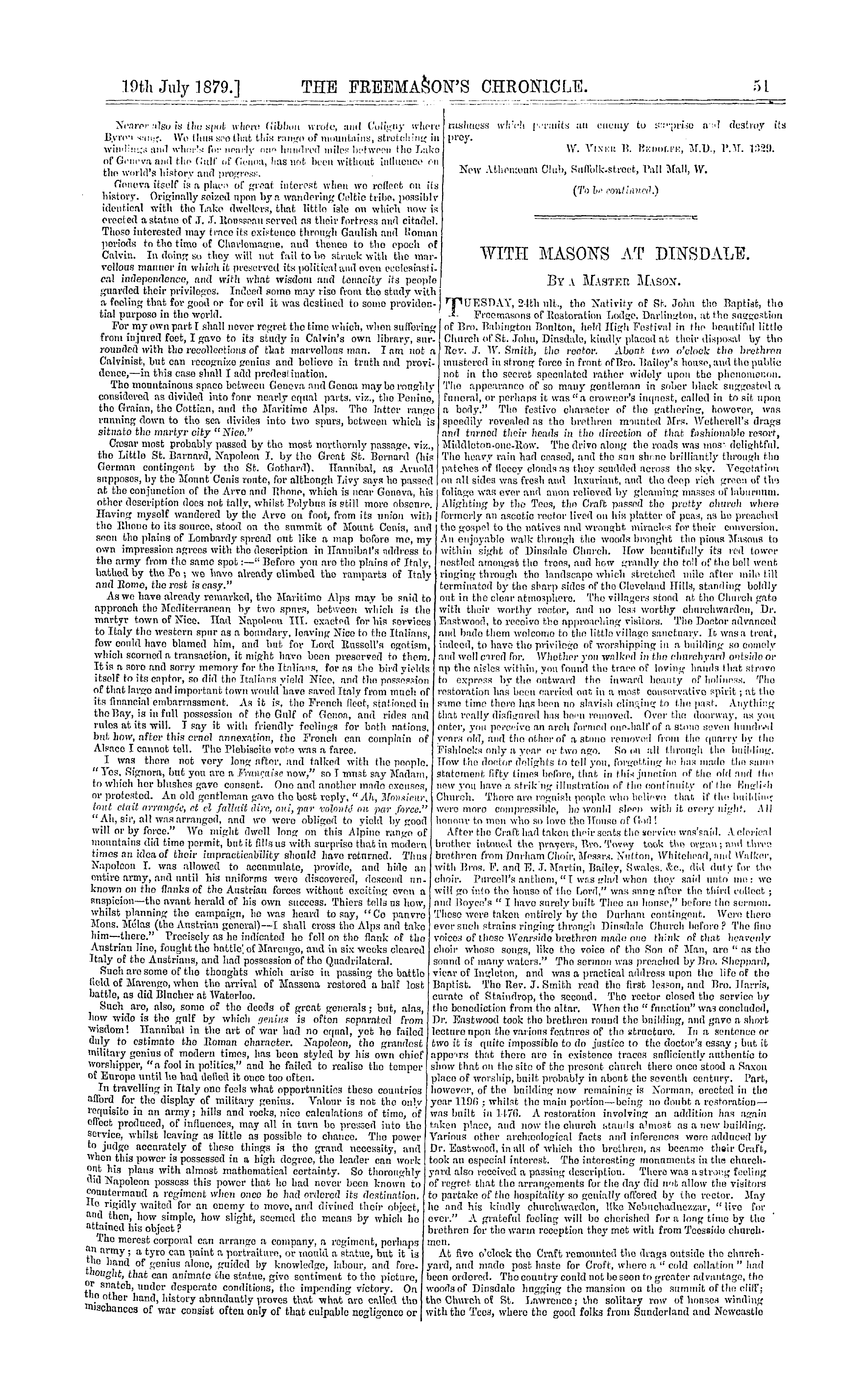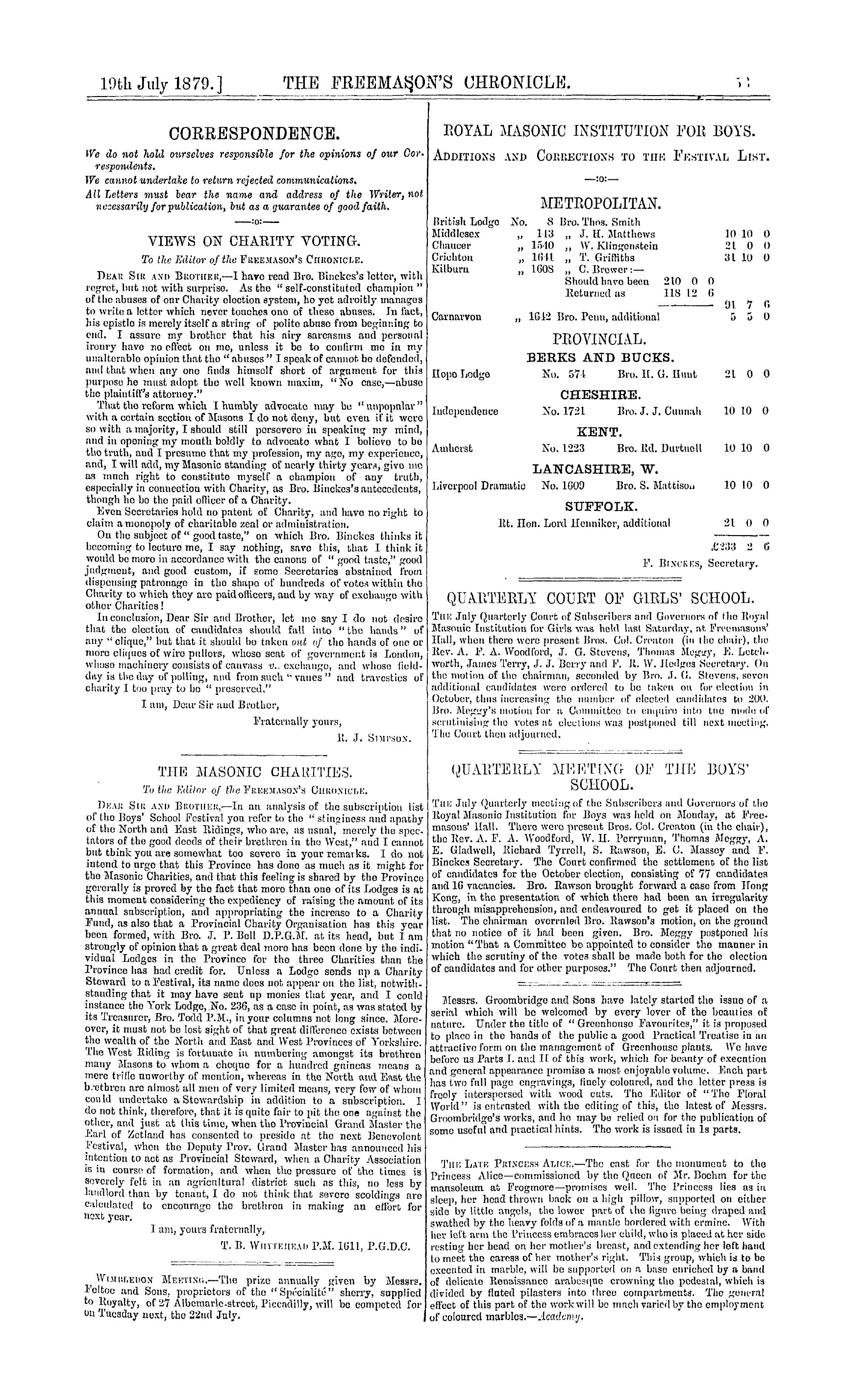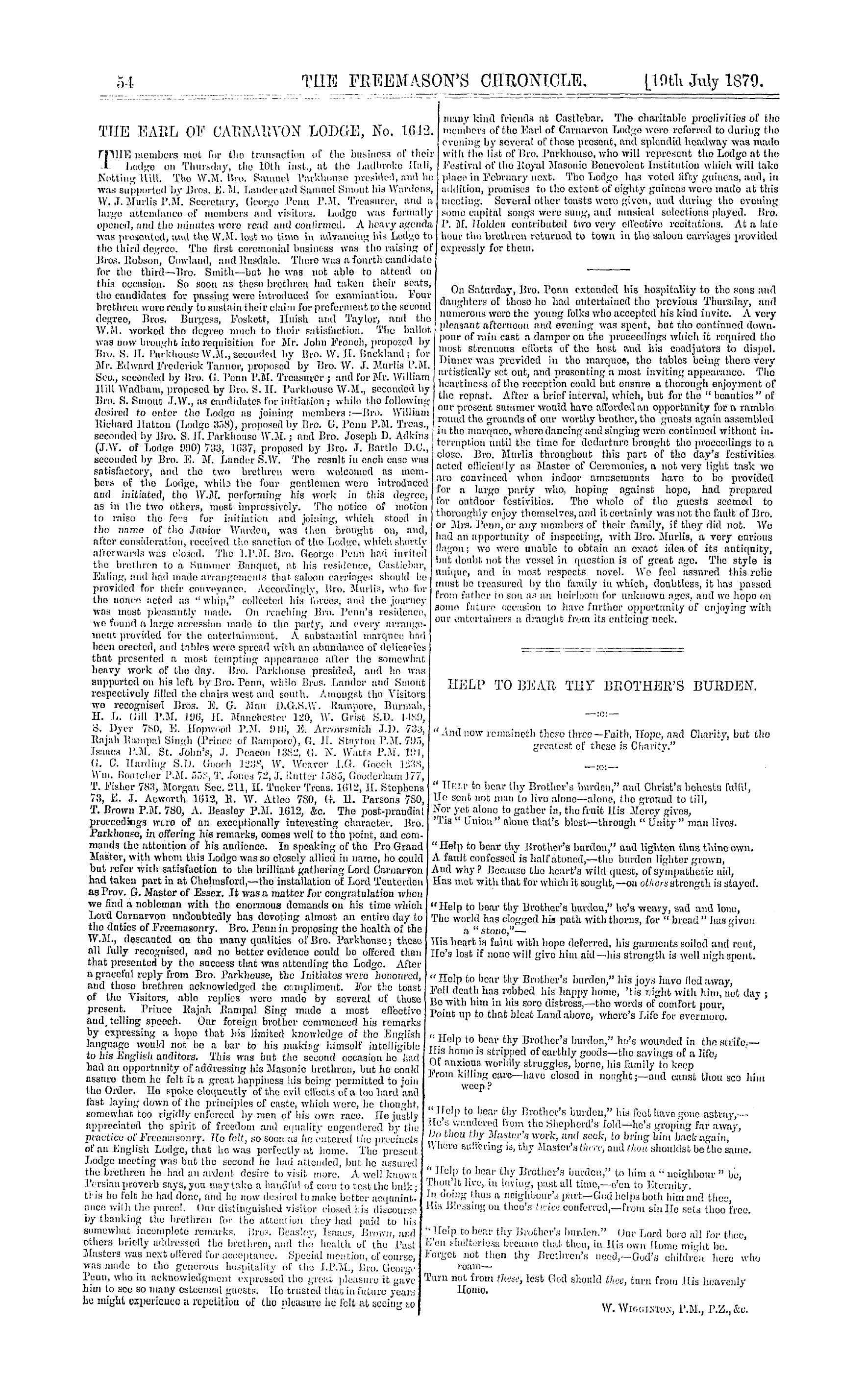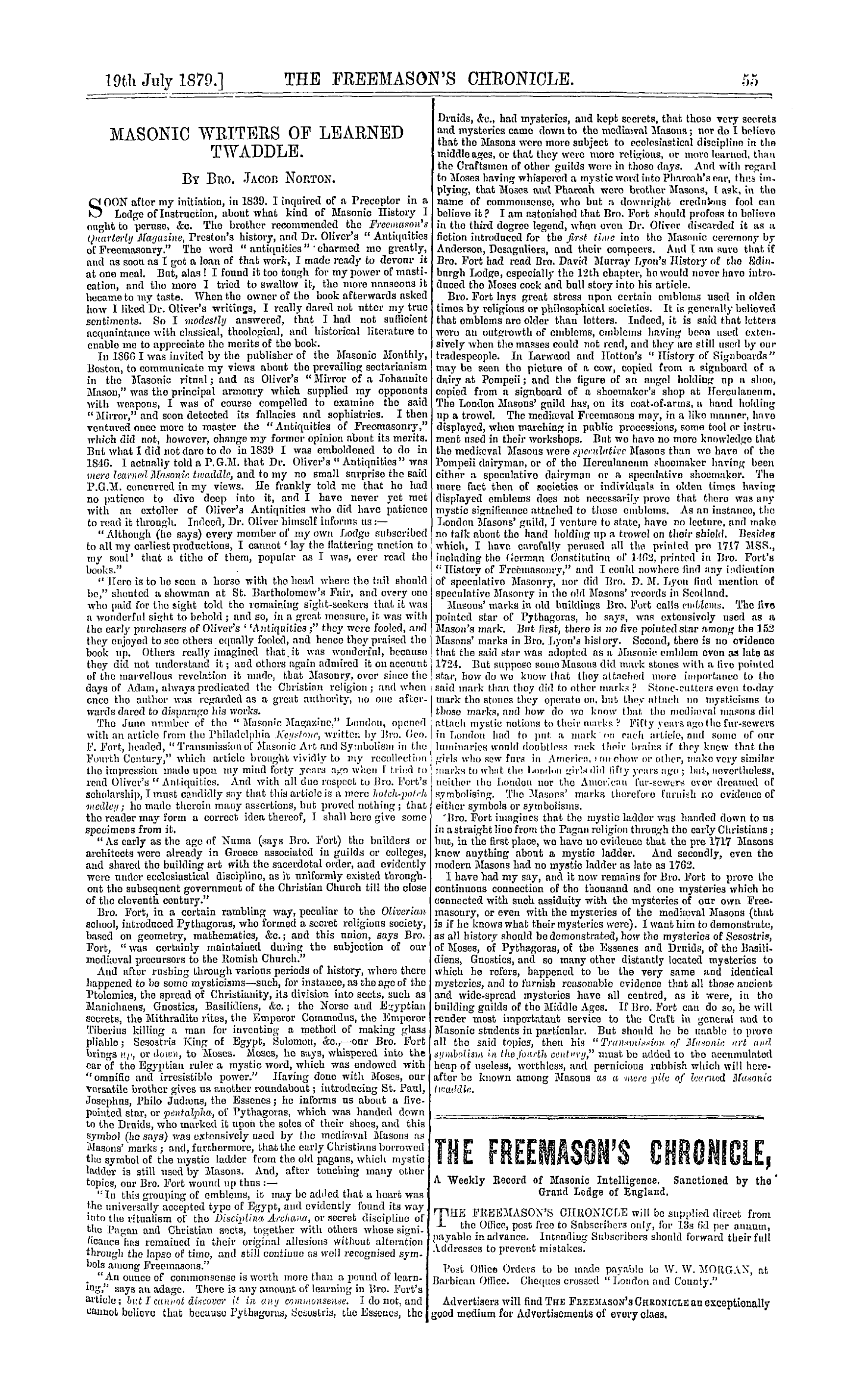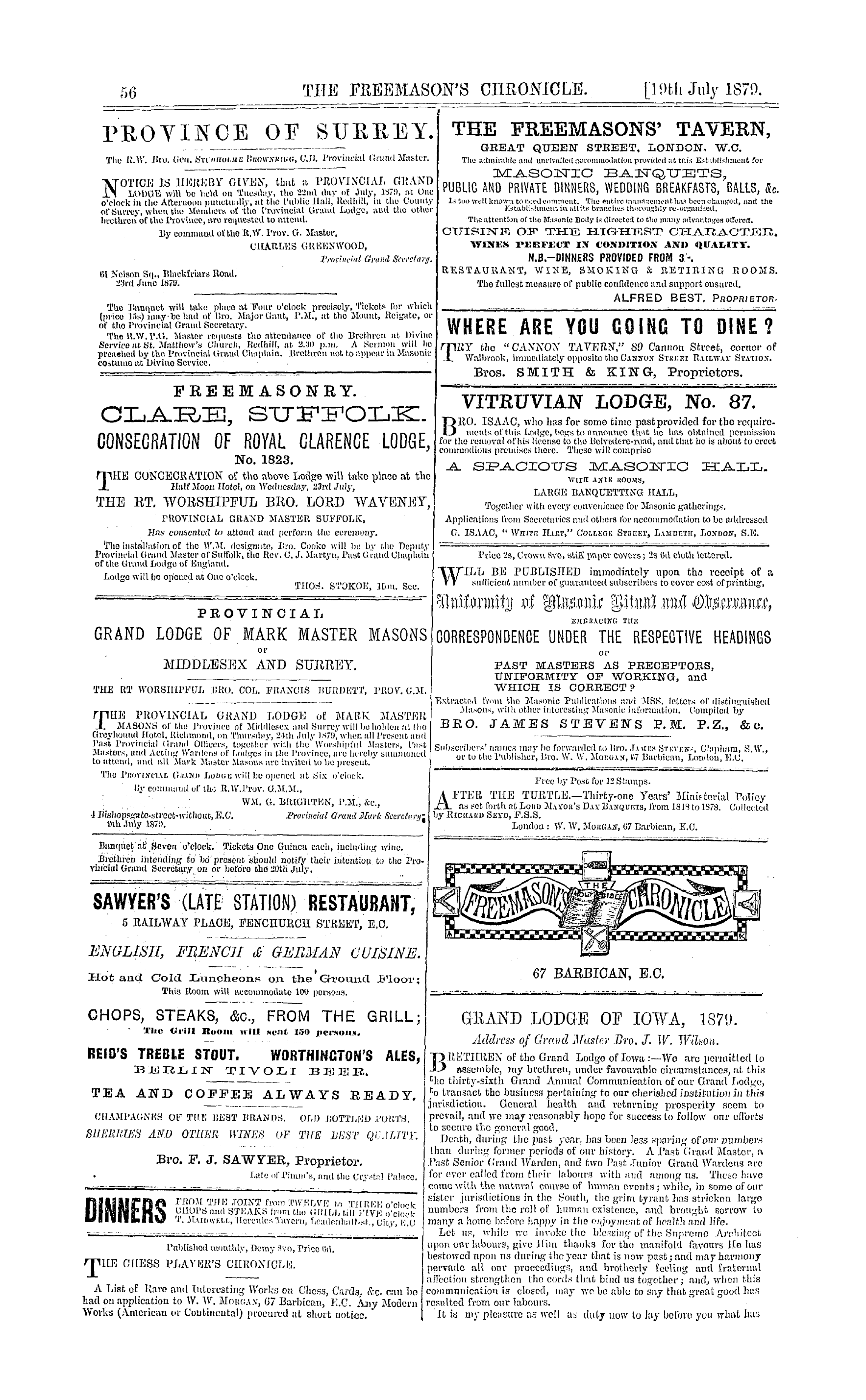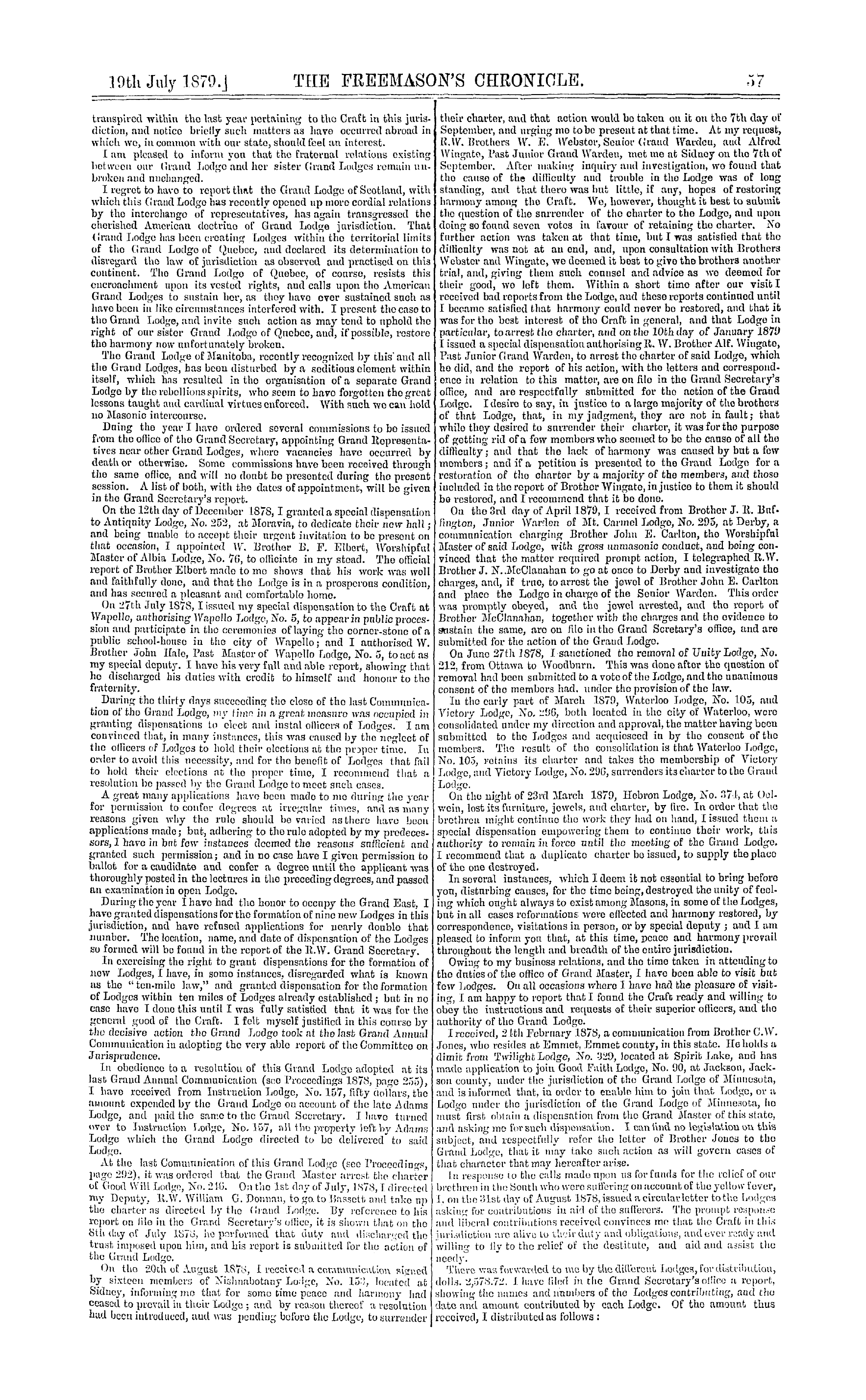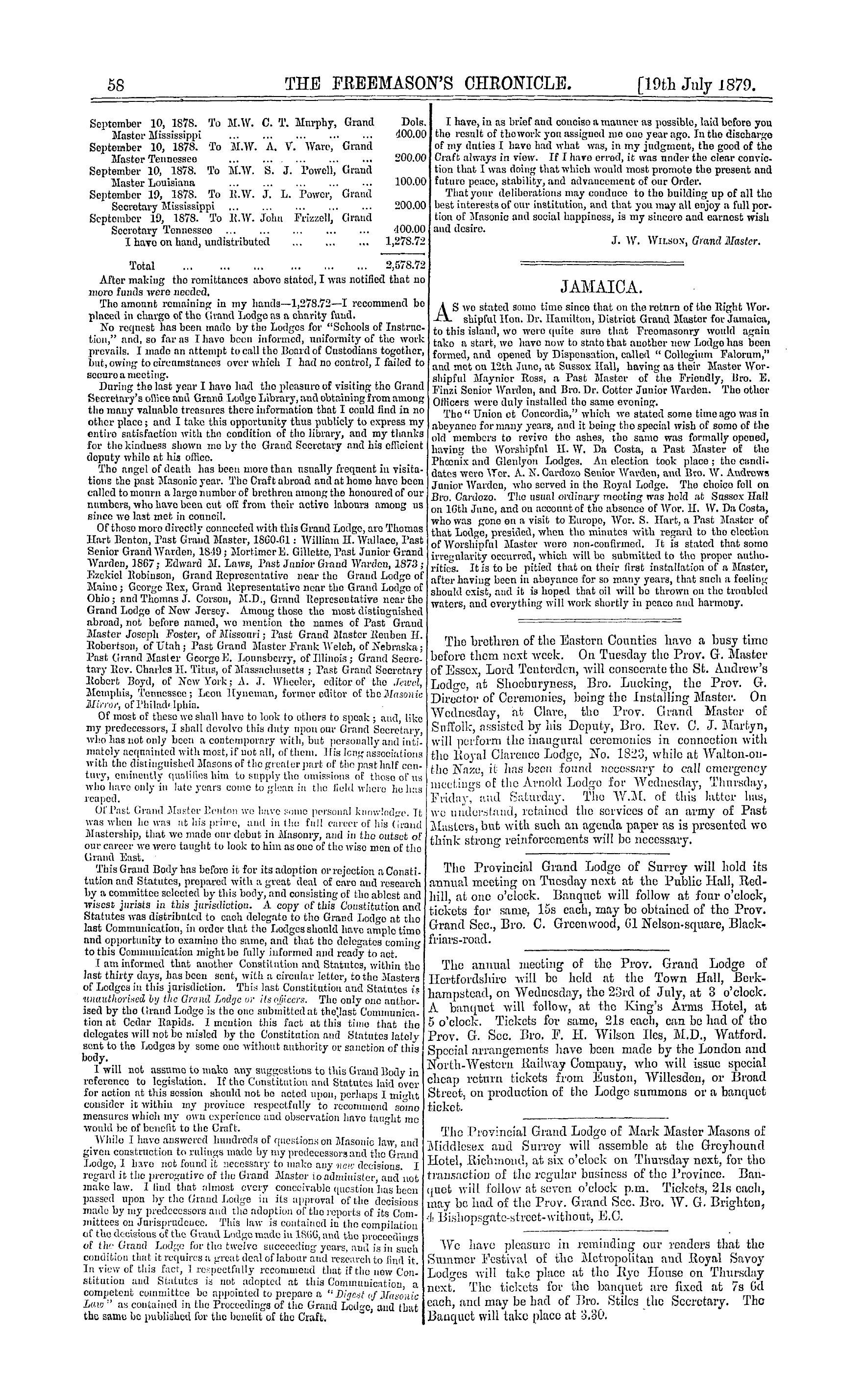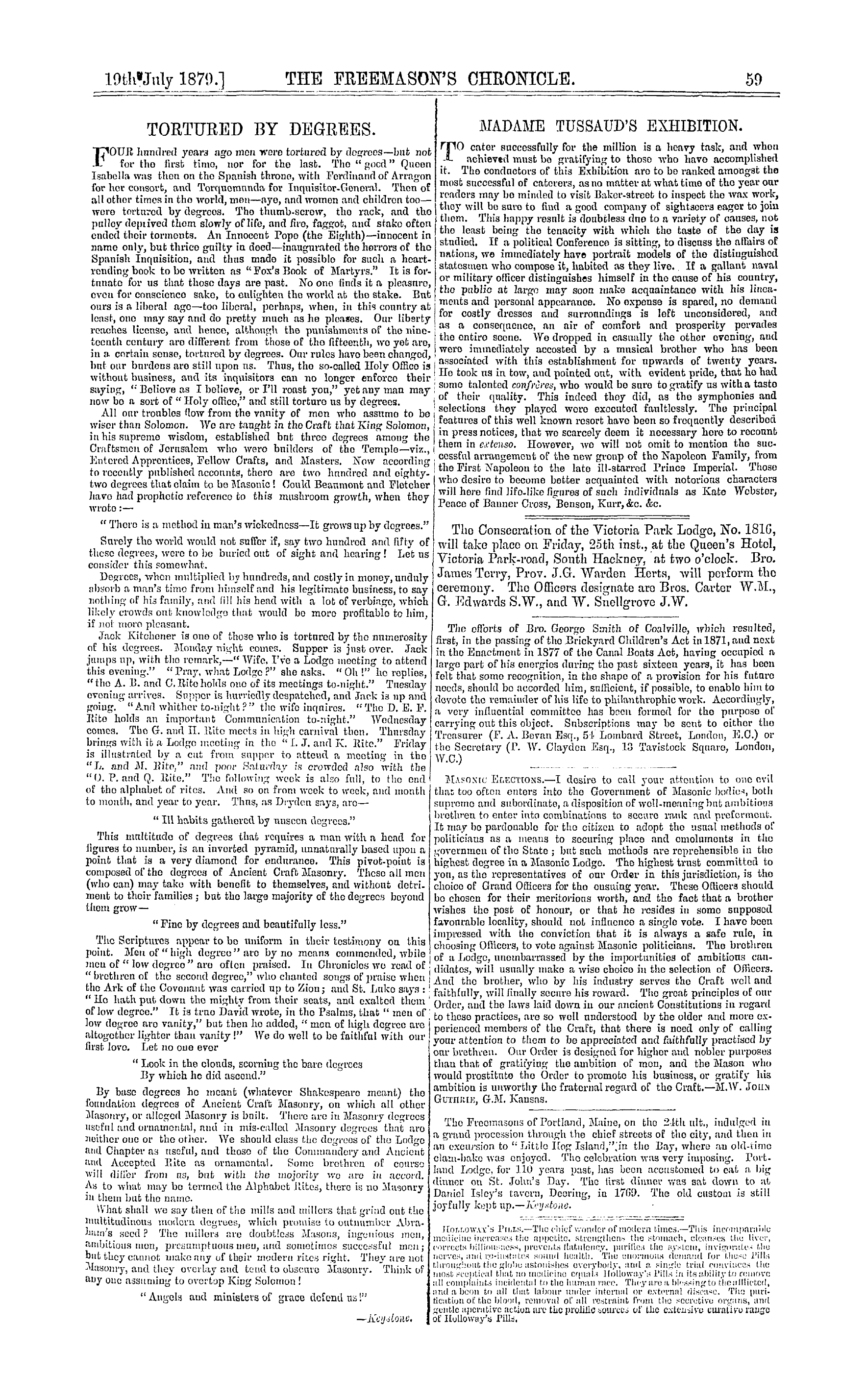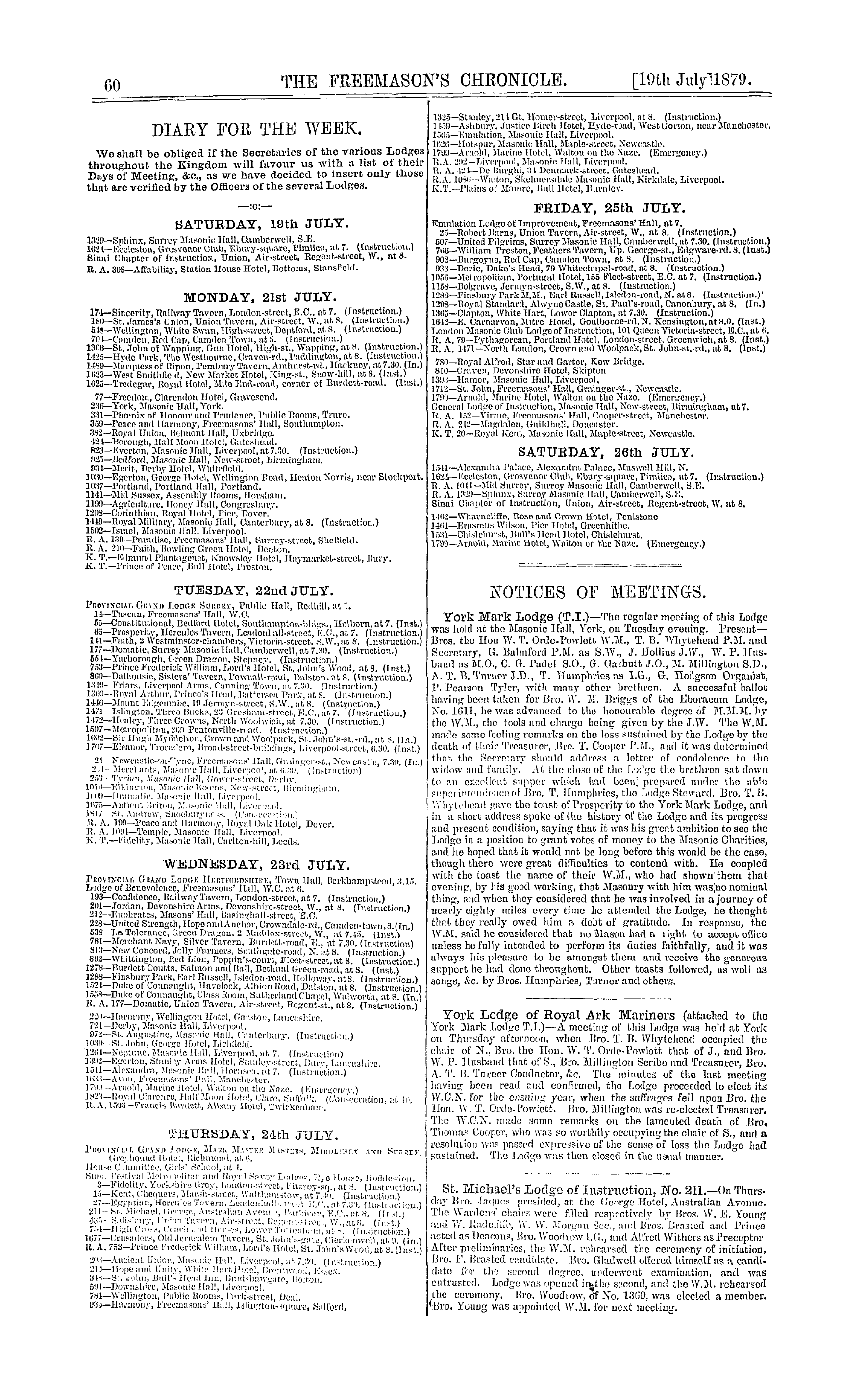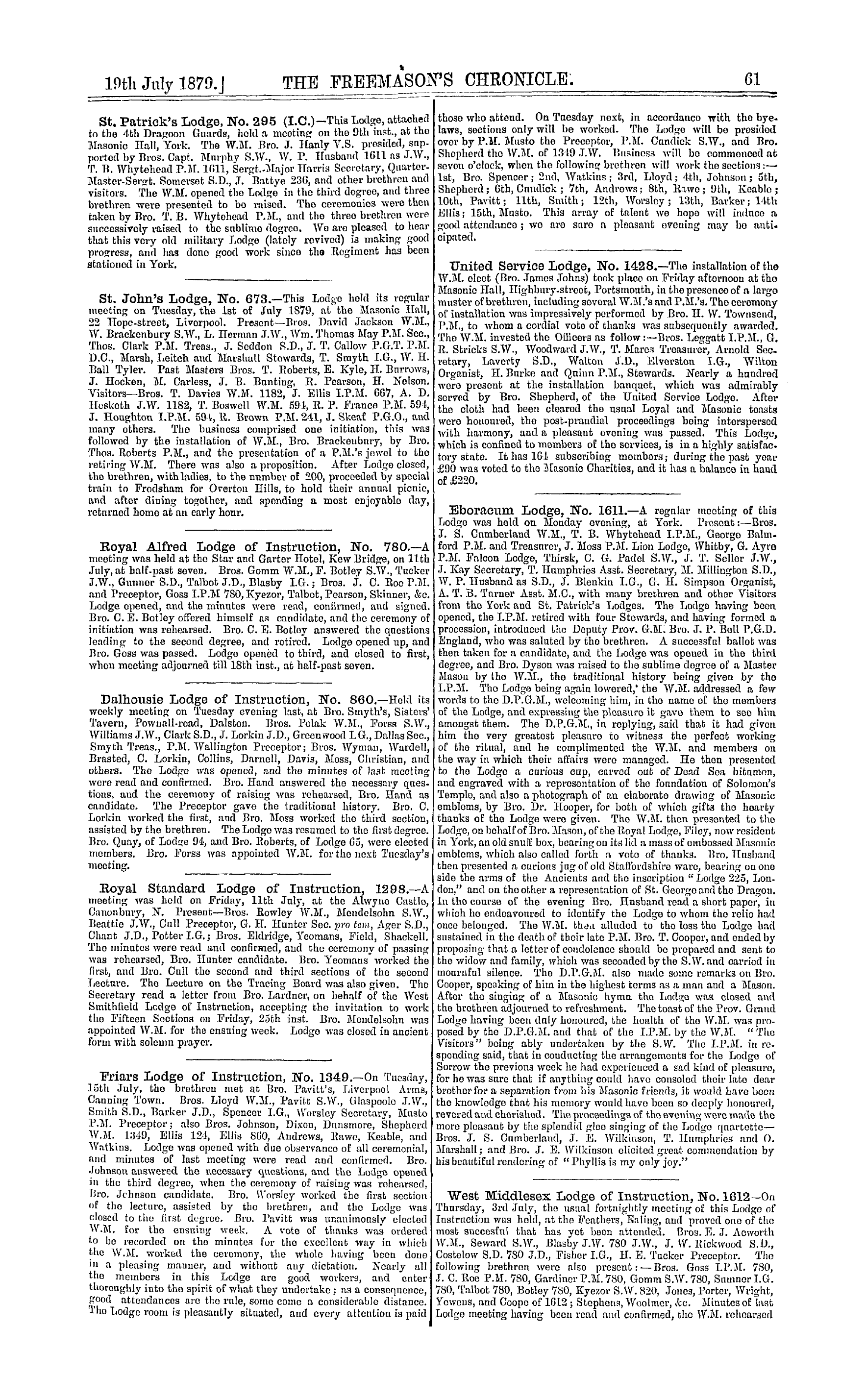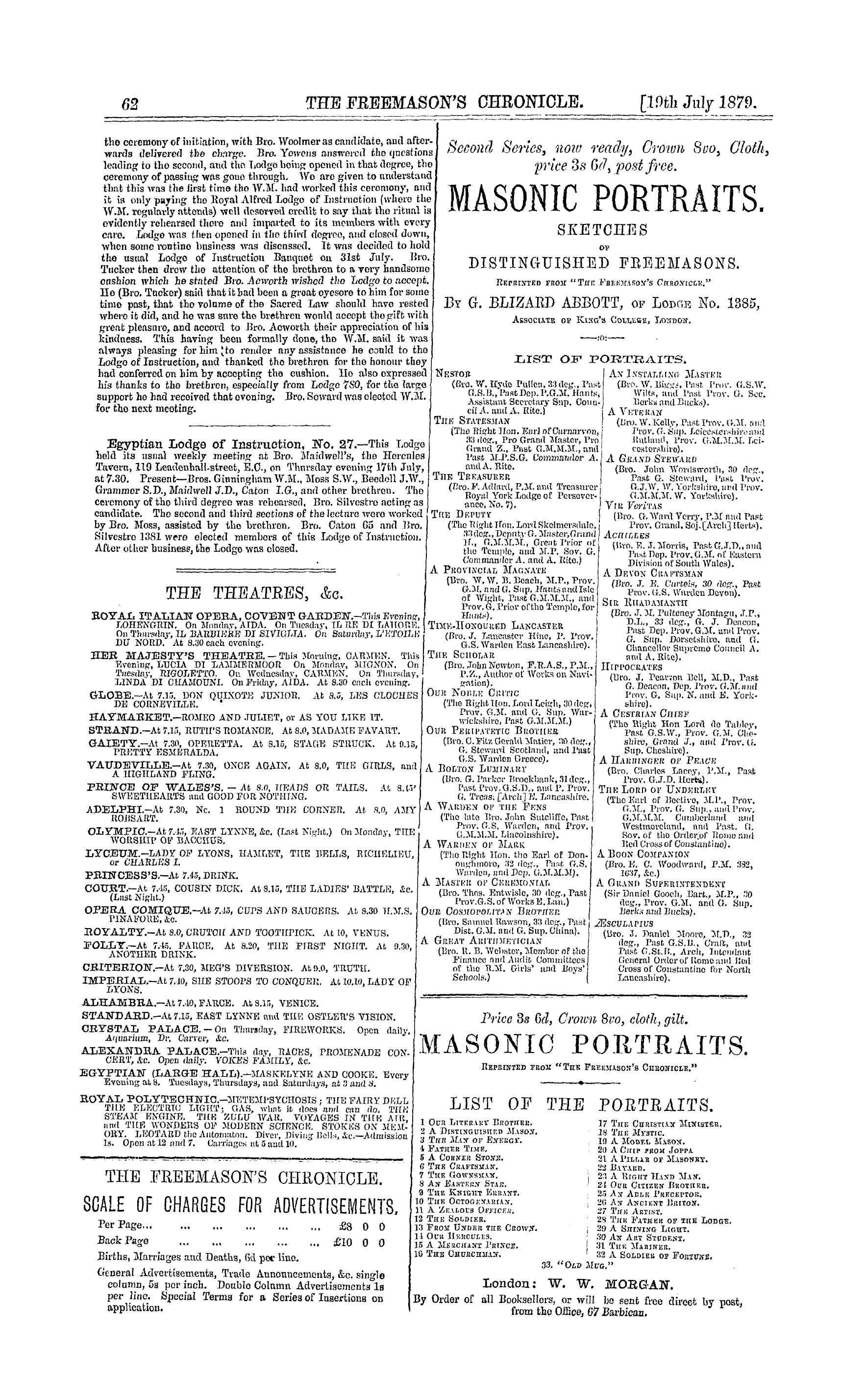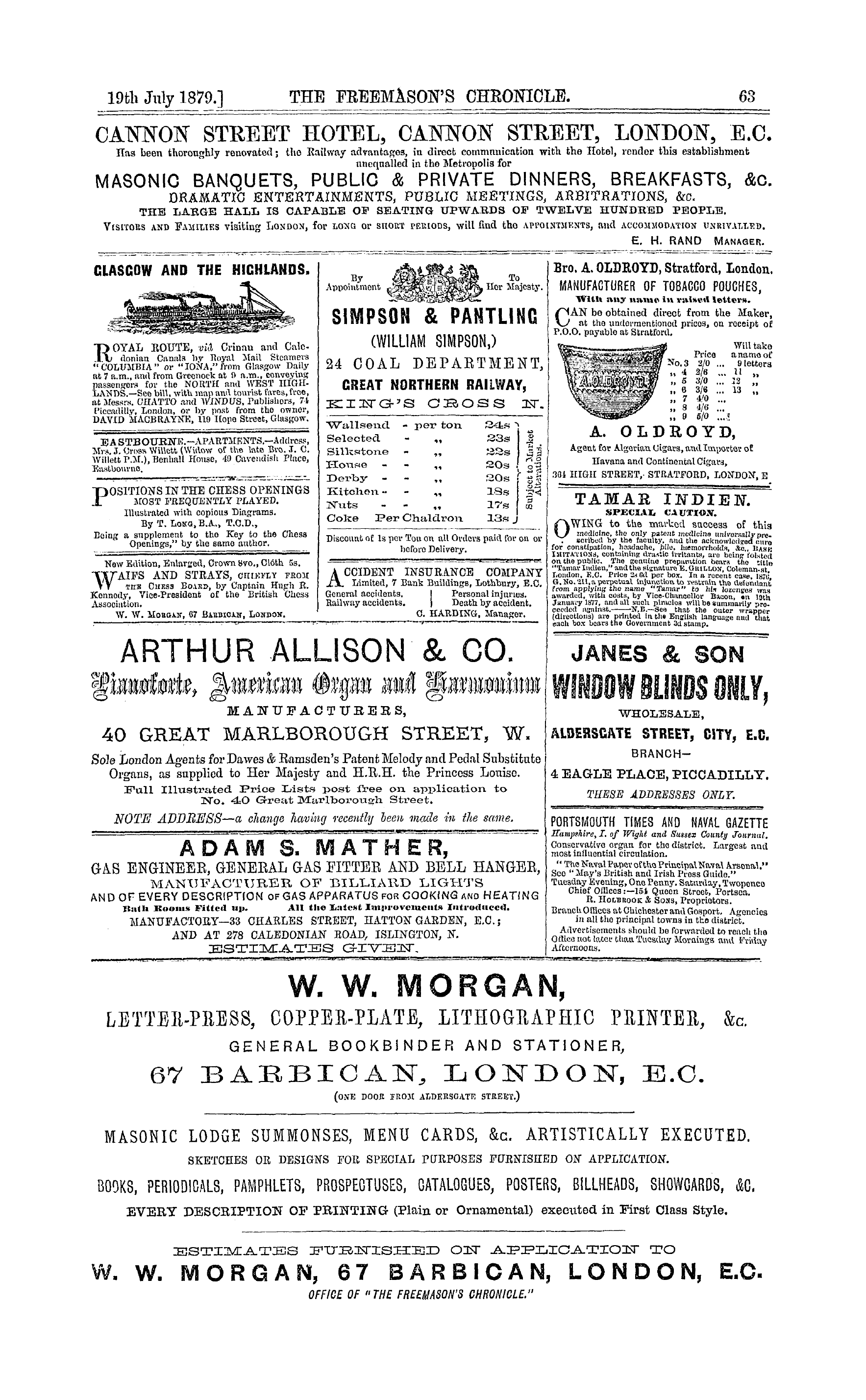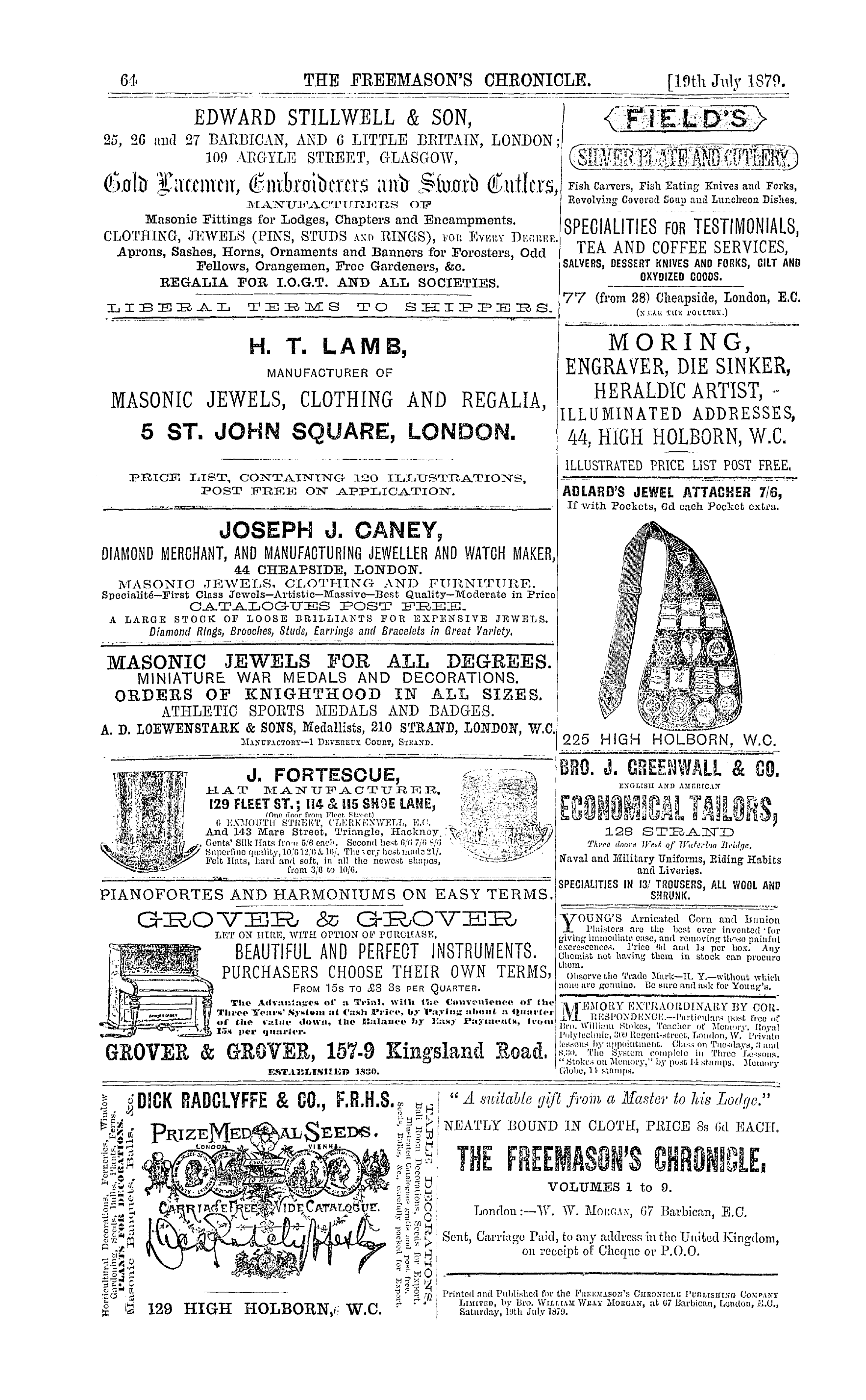-
Articles/Ads
Article MASONIC WRITERS OF LEARNED TWADDLE. Page 1 of 1 Article MASONIC WRITERS OF LEARNED TWADDLE. Page 1 of 1 Ad Untitled Page 1 of 1
Note: This text has been automatically extracted via Optical Character Recognition (OCR) software.
Masonic Writers Of Learned Twaddle.
MASONIC WRITERS OF LEARNED TWADDLE .
BY BRO . JACOB NORTON .
SOON after my initiation , in 1839 . I inquired of a Preceptor in a Lodge of Instruction , about what kind of Masonic History I ought to peruse , & c . Tho brother recommended fche Freemason ' s Quarterly Magazine , Preston ' s history , and Dr . Oliver ' s " Antiquities of Freemasonry . " Tho word " antiquities " ' charmed mo greatly , and as soon as I got a loan of that work , I made ready to devour it
at ono meal . But , alas ! I found it too tough for my power of mashcation , and the moro I tried to swallow it , tho moro nauseous it became to my taste . AVhen the owner of tho book afterwards asked how I liked Dr . Oliver's writings , I really dared nofc utter my true sentiments . So I modestly answered , that I had not sufficient acquaintance with classical , theological , and historical literature to
enable me to appreciate fche merits of the book . In I 860 I was invited by tho publisher of tho Masonic Monthly , Boston , to communicate my views about tho prevailing sectarianism in the Masonic ritnal ; and as Oliver ' s " Mirror of a Johannite Mason , " was tho principal armoury which supplied my opponents with weapons , I was of course compelled to examine the said
" Mirror , " and soon detected its fallacies and sophistries . I then ventured onco more to master the " Antiquities of Freemasonry , " which did not , however , change my former opinion abont its merits . But what I die ! not dare to do in 1839 I was emboldened to do in 1816 . I actually told a P . G . M . that Dr . Oliver ' s " Antiquities" was mere learned Masonic twaddle , and to my no small surprise the said
P . G . M . concurred in my views . He frankly told mo that ho had no patience to dive deep into it , and I have never yefc met with an cxtollor of Oliver ' s Antiquities who did have patience to read it through . Indeed , Dr . Oliver himself informs us : — " Although ( ho says ) every member of my own Lodge subscribed to all my earliest productions , I cannot' lay the flattering unction to
my soul' that a tithe of them , popular as I was , ever read tho books . " " Here is to bo seen a horse with tho head where tho tail shonld be , " shouted a showman at St . Bartholomew's Fair , and every ono who paid for tho sight told tho remaining sight-seekers that it was a wonderful sight to behold ; and so , in a great measure , ifc was with
the early purchasers of Oliver ' s ' 'Antiquities ; " they were fooled , arid they enjoyed to sec others equally fooled , and hence they praised tho book up . Others really imagined that , it was wonderful , because they did not understand it ; and others again admired it ou account of fcho marvellous revelation ifc made , that Masonry , ever since the days of Adam , always predicated the Christina religion ; and when
ence the author was regarded as a great authority , no one afterwards dared to disparage his works . Tho Juno number of tho " Masonic Magazine , " London , opened with an article from the Philadelphia Keystone , written by Bro . Geo . F . Fort , headed , " Transmission of Masonic Art aud Symbolism in the Fourth Century , " which article brought vividly to my recollection
the impression made npou my mind forty years ago when I tried to read Oliver ' s " Antiquities . And with all due respect to Bro . Fort ' s scholarship , I must candidly say that this article is a mere hotch-potek medley ; ho made therein many assertions , but proved nothing ; that tho reader may form a correct idea thereof , I shall hero give some specimens from it .
" As early as the age of Nnma ( says Bro . Fort ) the builders or architects were already in Greece associated in guilds or colleges , ancl shared tho building art ; with the sacerdotal order , ancl evidently were under ecclesiastical discipline , as it uniformly existed throughout the subsequent government of the Christian Church till tho close of tho eleventh century . "
Bro . Fort , in a certain rambling way , peculiar to tho Ohverian school , introduced Pythagoras , who formed a secret religions society , based on geometry , mathematics , & c ; and this union , says Bro . Fort , " was certainly maintained during the subjection of our mcdkoval precursors to the Romish Chnrch . " And after rushing through various periods of history , where there
happened to bo some mysticisms—such , for instance , as fche ago of the Ptolemies , the spread of Christianity , its division into sects , such as Manichaens , Gnostics , Basilidiens , & c ; fche Norso aud Egyptian secrets , the Mithradito rites , tho Emperor Coinmodus , the Emperor Tiberius killing a man for inventing a method of making glass pliable : Sesostris King of Egypt , Solomon , & c ., —our Bro . Fort
brings »;> , or doitni , to Moses . Moses , be says , whispered into the ear of tho Egyptian ruler a mystic word , which was endowed with " omnific ancl irresistible power . " Having done with Moses , outversatile brother gives us another roundabout ; introducing St . Paul , Josephus , Philo Judtons , the Essenes ; he informs us about a fivepointed star , or pent alpha , , of Pythagoras , which was handed clown
to the Druids , who marked it upon the soles of their shoes , and this symbol ( ho says ) was extensively used by the mcdircval Masons as Masons' marks ; and , furthermore , that the early Christians borrowed the symbol of the mystic ladder from the old pagans , which mystic ladder is still used by Masons . And , after touching many other topics , onr Bro . Fort wound up thus : —
"In this grouping of emblems , it may be added that a heart was the universally accepted type of Egypt , aud evidently found its way into the ritualism of tho Disciplina Archana , or secret discipliue of the Pagan and Christian sects , together with others whose significance has remained in their original allusions without alteration
through the lapse of time , and still continue r , s well recognised symbols among Freemasons . " "An ounce of commonsense is worth more than a pound of learning , " says an adage . There is any amount of learning in Bro . Fort ' s article ; hut I caneot discover it in any commonsense . I do not , ancl cannot believe that because Pythagoras , Sesostris , the Essenes , the
Masonic Writers Of Learned Twaddle.
Druids , 4 c , had mysteries , and kept secrets , thafc thoso very secrets and mysteries came down to tho mediaeval Masons ; nor do I believe thafc the Masons wero more subject to ecclesiastical discipline in the middle ages , or that they wero moro religious , or moro learned , than the Craftsmen of other guilds wero in thoso days . And with regard to Moses having whispered a mystic word into Pharoah ' s ear , thus
implying , that Moses and Pharoab wero brother Masons , I ask , in tho name of commonsense , who but a downright credni »> us fool can believe it ? I am astonished that Bro . Fort should profess to believe iu tho third degree legend , whqn oven Dr . Oliver discarded it as a fiction introduced for the first time into tho Masonic ceremony by Anderson , Desagnliers , and their compeers . And I am sure that if
Bro . Fort had read Bro . David Murray Lyon ' s History of the Edinburgh Lodge , especially the 12 th chapter , he would never havo introduced tho Moses cock and bull story into his article . Bro . Fort lays great stress npon certain emblems used in olden times by religions or philosophical societies . It is generally believed that emblems aro older than letters . Indeed , it is said that letters
were an outgrowth of emblems , emblems having been used extensively when tho masses conld not read , and they aro still used by our tradespeople . In Larwaod and Hotton ' s " History of Signboards " may bo seen tho picture of a cow , copied from a signboard of a dairy at Pompeii ; and the figure of an angel holding up a shoe , copied from a signboard of a shoemaker ' s shop at Horculanenm .
Tho London Masons' guild has , on its coat-of-arms , u hand holding np a trowel . The mediaeval Freemasons may , in a like manner , have displayed , when marching in public processions , some tool or instrument used in their workshops . But wo havo no moro knowledge that the mediicval Masons wore speculative Masons than wo have of tho Pompeii dairyman , or of the Herciilaneum shoemaker having been
either a speculative dairyman or a speculative shoemaker . The mere fact then of societies or individuals in olden times having displayed emblems does nofc necessarily prove thafc thero was any mystic significance attached to those emblems . As an instance , the London Masons' guild , I venture to state , havo no lecture , and make no talk abont tho hand holding up a trowel on their shield . Besides
which , I have carefully perused all the printed pro 1717 MSS ., including the German Constitution of 1162 , printed in Bro . Fort ' s "History of Freemasonry , " and I conld nowhere find any indication of speculative Masonry , nor did Bro . D . M . Lyon find mention of speculative Masonry in tho old Masons' records in Scotland . Masons' marks in old buildings Bro . Fort calls emblems . The five
pointed star of Pythagoras , ho says , was extensively used as a Mason ' s mark . But first , thero is no five pointed star . among the 152 Masons' marks in Bro . Lyon ' s history . Second , there is no evidence that the said star was adopted as a Masonic emblem even as late as 1724 . But suppose some Masons did mark stones with a live pointed star , how clo we know that thoy attached more importance to tho
said mark than they did to other marks ? Stone-cutters oven to-day mark tho stones they operate on , but they attach no mysticisms to those marks , and how clo wo know that tho mediicval masons did attach mystic notions to their marks V Fifty years ago the fur-sewers in London had to put . a mark ' mi each article , nnd some of onr
luminaries would doubtless rack their brains if tbey know that the girls who sew furs in America , » on ehow or other , make very similar marks to what the London girl * did fifty years ago ; but , nevertheless , neither the Loudon nor the American I ' ur-sewcrs ever dreamed of svmbolisinD' . The Masons' marks therefore furnish no evidence of
either symbols or symbolisms . 'Bro . Fort imagines that the mystic ladder was handed down to us in a straight line from the Pagan religion through the early Christians ; but , in the first place , wo have no evidence that the pre 1717 Masons know anything about a mystic ladder . And secondly , even the modern Masons had no mystic ladder as late as 1762 .
I have had my say , and ifc now remains for Bro . Fort to prove tho continuous connection of tho thousand and one mysteries which he connected with such assiduity with the . mysteries of our own Freemasonry , or even with the mysteries of the racdiaoval Masons ( that is if he knows what their mysteries were ) . I want him to demonstrate , as all history should be demonstrated , how the mysteries of Sesostris ,
of Moses , of Pythagoras , of the Essenes and Druids , of tho Basilidiens , Gnostics , ancl so many other distantly located mysteries to which he refers , happened to be the very same and identical mysteries , and to furnish reasonable evidence that all those ancient and wide-spread mysteries have all centred , as it were , in the building guilds of tho Middle Ages . If Bro . Fort can do so , he will
render most importatant service to the Craft in general aud to Masonic students in particular . But shonld he be unable to prove all tho said topics , then his " Trtinxmissioit of Masonic art and s > i » ibol . i $ ) n > -n the fourth century , " must be added to tho accumulated heap of useless , worthless , and pernicious rubbish which will hereafter be known among Masons as a mere pile of learned Masonic twaddle .
Ad00702
THEFREEMASON'SOHROMiOLE, A "Weekly Piecord of Masonic Intelligence . Sanctioned by tho * Grand Lodge of England . rpHE FREEMASON'S CHRONICLE will be supplied direct from - « - the Office , post freo to Subscribers only , for 13 s fid per annum , payable in advance . Intending Subscribers should forward their full Addresses to prevent mistakes . Post Office Orders to be made payable to AV . AV . MORGAN , at Barbican Office . Cheques crossed " London and County . " Advertisers will find THE FREEMASON ' CHRONICLE au exceptionally good medium for Advertisements of every class .
Note: This text has been automatically extracted via Optical Character Recognition (OCR) software.
Masonic Writers Of Learned Twaddle.
MASONIC WRITERS OF LEARNED TWADDLE .
BY BRO . JACOB NORTON .
SOON after my initiation , in 1839 . I inquired of a Preceptor in a Lodge of Instruction , about what kind of Masonic History I ought to peruse , & c . Tho brother recommended fche Freemason ' s Quarterly Magazine , Preston ' s history , and Dr . Oliver ' s " Antiquities of Freemasonry . " Tho word " antiquities " ' charmed mo greatly , and as soon as I got a loan of that work , I made ready to devour it
at ono meal . But , alas ! I found it too tough for my power of mashcation , and the moro I tried to swallow it , tho moro nauseous it became to my taste . AVhen the owner of tho book afterwards asked how I liked Dr . Oliver's writings , I really dared nofc utter my true sentiments . So I modestly answered , that I had not sufficient acquaintance with classical , theological , and historical literature to
enable me to appreciate fche merits of the book . In I 860 I was invited by tho publisher of tho Masonic Monthly , Boston , to communicate my views about tho prevailing sectarianism in the Masonic ritnal ; and as Oliver ' s " Mirror of a Johannite Mason , " was tho principal armoury which supplied my opponents with weapons , I was of course compelled to examine the said
" Mirror , " and soon detected its fallacies and sophistries . I then ventured onco more to master the " Antiquities of Freemasonry , " which did not , however , change my former opinion abont its merits . But what I die ! not dare to do in 1839 I was emboldened to do in 1816 . I actually told a P . G . M . that Dr . Oliver ' s " Antiquities" was mere learned Masonic twaddle , and to my no small surprise the said
P . G . M . concurred in my views . He frankly told mo that ho had no patience to dive deep into it , and I have never yefc met with an cxtollor of Oliver ' s Antiquities who did have patience to read it through . Indeed , Dr . Oliver himself informs us : — " Although ( ho says ) every member of my own Lodge subscribed to all my earliest productions , I cannot' lay the flattering unction to
my soul' that a tithe of them , popular as I was , ever read tho books . " " Here is to bo seen a horse with tho head where tho tail shonld be , " shouted a showman at St . Bartholomew's Fair , and every ono who paid for tho sight told tho remaining sight-seekers that it was a wonderful sight to behold ; and so , in a great measure , ifc was with
the early purchasers of Oliver ' s ' 'Antiquities ; " they were fooled , arid they enjoyed to sec others equally fooled , and hence they praised tho book up . Others really imagined that , it was wonderful , because they did not understand it ; and others again admired it ou account of fcho marvellous revelation ifc made , that Masonry , ever since the days of Adam , always predicated the Christina religion ; and when
ence the author was regarded as a great authority , no one afterwards dared to disparage his works . Tho Juno number of tho " Masonic Magazine , " London , opened with an article from the Philadelphia Keystone , written by Bro . Geo . F . Fort , headed , " Transmission of Masonic Art aud Symbolism in the Fourth Century , " which article brought vividly to my recollection
the impression made npou my mind forty years ago when I tried to read Oliver ' s " Antiquities . And with all due respect to Bro . Fort ' s scholarship , I must candidly say that this article is a mere hotch-potek medley ; ho made therein many assertions , but proved nothing ; that tho reader may form a correct idea thereof , I shall hero give some specimens from it .
" As early as the age of Nnma ( says Bro . Fort ) the builders or architects were already in Greece associated in guilds or colleges , ancl shared tho building art ; with the sacerdotal order , ancl evidently were under ecclesiastical discipline , as it uniformly existed throughout the subsequent government of the Christian Church till tho close of tho eleventh century . "
Bro . Fort , in a certain rambling way , peculiar to tho Ohverian school , introduced Pythagoras , who formed a secret religions society , based on geometry , mathematics , & c ; and this union , says Bro . Fort , " was certainly maintained during the subjection of our mcdkoval precursors to the Romish Chnrch . " And after rushing through various periods of history , where there
happened to bo some mysticisms—such , for instance , as fche ago of the Ptolemies , the spread of Christianity , its division into sects , such as Manichaens , Gnostics , Basilidiens , & c ; fche Norso aud Egyptian secrets , the Mithradito rites , tho Emperor Coinmodus , the Emperor Tiberius killing a man for inventing a method of making glass pliable : Sesostris King of Egypt , Solomon , & c ., —our Bro . Fort
brings »;> , or doitni , to Moses . Moses , be says , whispered into the ear of tho Egyptian ruler a mystic word , which was endowed with " omnific ancl irresistible power . " Having done with Moses , outversatile brother gives us another roundabout ; introducing St . Paul , Josephus , Philo Judtons , the Essenes ; he informs us about a fivepointed star , or pent alpha , , of Pythagoras , which was handed clown
to the Druids , who marked it upon the soles of their shoes , and this symbol ( ho says ) was extensively used by the mcdircval Masons as Masons' marks ; and , furthermore , that the early Christians borrowed the symbol of the mystic ladder from the old pagans , which mystic ladder is still used by Masons . And , after touching many other topics , onr Bro . Fort wound up thus : —
"In this grouping of emblems , it may be added that a heart was the universally accepted type of Egypt , aud evidently found its way into the ritualism of tho Disciplina Archana , or secret discipliue of the Pagan and Christian sects , together with others whose significance has remained in their original allusions without alteration
through the lapse of time , and still continue r , s well recognised symbols among Freemasons . " "An ounce of commonsense is worth more than a pound of learning , " says an adage . There is any amount of learning in Bro . Fort ' s article ; hut I caneot discover it in any commonsense . I do not , ancl cannot believe that because Pythagoras , Sesostris , the Essenes , the
Masonic Writers Of Learned Twaddle.
Druids , 4 c , had mysteries , and kept secrets , thafc thoso very secrets and mysteries came down to tho mediaeval Masons ; nor do I believe thafc the Masons wero more subject to ecclesiastical discipline in the middle ages , or that they wero moro religious , or moro learned , than the Craftsmen of other guilds wero in thoso days . And with regard to Moses having whispered a mystic word into Pharoah ' s ear , thus
implying , that Moses and Pharoab wero brother Masons , I ask , in tho name of commonsense , who but a downright credni »> us fool can believe it ? I am astonished that Bro . Fort should profess to believe iu tho third degree legend , whqn oven Dr . Oliver discarded it as a fiction introduced for the first time into tho Masonic ceremony by Anderson , Desagnliers , and their compeers . And I am sure that if
Bro . Fort had read Bro . David Murray Lyon ' s History of the Edinburgh Lodge , especially the 12 th chapter , he would never havo introduced tho Moses cock and bull story into his article . Bro . Fort lays great stress npon certain emblems used in olden times by religions or philosophical societies . It is generally believed that emblems aro older than letters . Indeed , it is said that letters
were an outgrowth of emblems , emblems having been used extensively when tho masses conld not read , and they aro still used by our tradespeople . In Larwaod and Hotton ' s " History of Signboards " may bo seen tho picture of a cow , copied from a signboard of a dairy at Pompeii ; and the figure of an angel holding up a shoe , copied from a signboard of a shoemaker ' s shop at Horculanenm .
Tho London Masons' guild has , on its coat-of-arms , u hand holding np a trowel . The mediaeval Freemasons may , in a like manner , have displayed , when marching in public processions , some tool or instrument used in their workshops . But wo havo no moro knowledge that the mediicval Masons wore speculative Masons than wo have of tho Pompeii dairyman , or of the Herciilaneum shoemaker having been
either a speculative dairyman or a speculative shoemaker . The mere fact then of societies or individuals in olden times having displayed emblems does nofc necessarily prove thafc thero was any mystic significance attached to those emblems . As an instance , the London Masons' guild , I venture to state , havo no lecture , and make no talk abont tho hand holding up a trowel on their shield . Besides
which , I have carefully perused all the printed pro 1717 MSS ., including the German Constitution of 1162 , printed in Bro . Fort ' s "History of Freemasonry , " and I conld nowhere find any indication of speculative Masonry , nor did Bro . D . M . Lyon find mention of speculative Masonry in tho old Masons' records in Scotland . Masons' marks in old buildings Bro . Fort calls emblems . The five
pointed star of Pythagoras , ho says , was extensively used as a Mason ' s mark . But first , thero is no five pointed star . among the 152 Masons' marks in Bro . Lyon ' s history . Second , there is no evidence that the said star was adopted as a Masonic emblem even as late as 1724 . But suppose some Masons did mark stones with a live pointed star , how clo we know that thoy attached more importance to tho
said mark than they did to other marks ? Stone-cutters oven to-day mark tho stones they operate on , but they attach no mysticisms to those marks , and how clo wo know that tho mediicval masons did attach mystic notions to their marks V Fifty years ago the fur-sewers in London had to put . a mark ' mi each article , nnd some of onr
luminaries would doubtless rack their brains if tbey know that the girls who sew furs in America , » on ehow or other , make very similar marks to what the London girl * did fifty years ago ; but , nevertheless , neither the Loudon nor the American I ' ur-sewcrs ever dreamed of svmbolisinD' . The Masons' marks therefore furnish no evidence of
either symbols or symbolisms . 'Bro . Fort imagines that the mystic ladder was handed down to us in a straight line from the Pagan religion through the early Christians ; but , in the first place , wo have no evidence that the pre 1717 Masons know anything about a mystic ladder . And secondly , even the modern Masons had no mystic ladder as late as 1762 .
I have had my say , and ifc now remains for Bro . Fort to prove tho continuous connection of tho thousand and one mysteries which he connected with such assiduity with the . mysteries of our own Freemasonry , or even with the mysteries of the racdiaoval Masons ( that is if he knows what their mysteries were ) . I want him to demonstrate , as all history should be demonstrated , how the mysteries of Sesostris ,
of Moses , of Pythagoras , of the Essenes and Druids , of tho Basilidiens , Gnostics , ancl so many other distantly located mysteries to which he refers , happened to be the very same and identical mysteries , and to furnish reasonable evidence that all those ancient and wide-spread mysteries have all centred , as it were , in the building guilds of tho Middle Ages . If Bro . Fort can do so , he will
render most importatant service to the Craft in general aud to Masonic students in particular . But shonld he be unable to prove all tho said topics , then his " Trtinxmissioit of Masonic art and s > i » ibol . i $ ) n > -n the fourth century , " must be added to tho accumulated heap of useless , worthless , and pernicious rubbish which will hereafter be known among Masons as a mere pile of learned Masonic twaddle .
Ad00702
THEFREEMASON'SOHROMiOLE, A "Weekly Piecord of Masonic Intelligence . Sanctioned by tho * Grand Lodge of England . rpHE FREEMASON'S CHRONICLE will be supplied direct from - « - the Office , post freo to Subscribers only , for 13 s fid per annum , payable in advance . Intending Subscribers should forward their full Addresses to prevent mistakes . Post Office Orders to be made payable to AV . AV . MORGAN , at Barbican Office . Cheques crossed " London and County . " Advertisers will find THE FREEMASON ' CHRONICLE au exceptionally good medium for Advertisements of every class .
